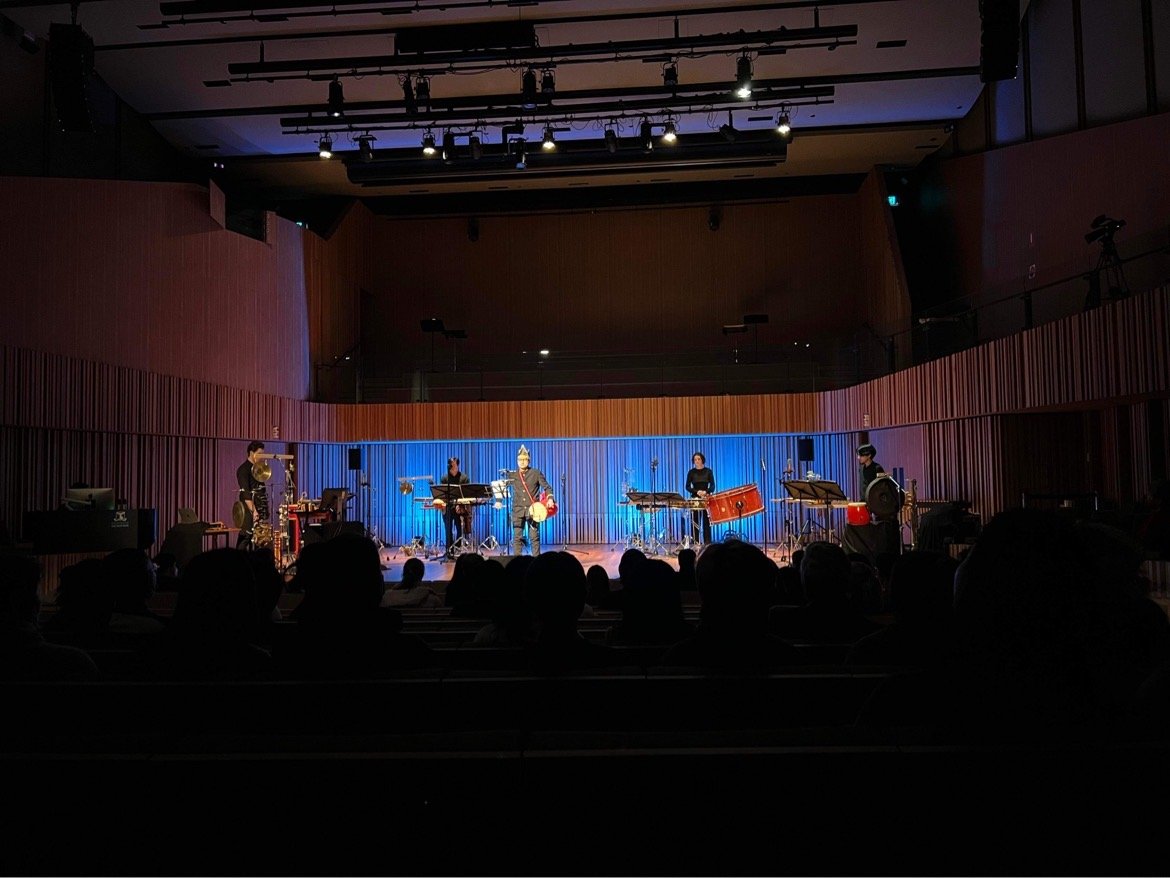Rhythms and Rituals
29 July 2022
WHACKollective’s debut full-length concert through the New Music Studio

Video Gallery
Program
-
What Hath II is a fully notated percussion quartet which explores and abstracts encoded methods of communication. The ensemble uses sound, light, and movement to explicate patterns derived from binary code, morse code, and light coding. The aural, visual, and physical fuse together into a common language.
Read more about Kate Neal here : http://www.kateneal.com/about-2/
-
for 8 brake drums
-
Read about Zhao Yiran here : http://www.yiranzhao.net/about-english/
-
for crotales & electric fan
www.bridgetbourne.com
-
Where Butterflies Sleep is inspired by a project worked on at the butterfly house at the Melbourne Zoo and research into how butterflies perceive sound and relate to colours. Butterflies have tiny ears that respond to high and low frequencies in different ways. When high frequency sounds are heard they generally remain at rest hidden by colours (red, yellow, purple and orange being the most popular). This is possibly related to perceiving the high frequencies of predator bird song. They will fly away when hearing lower frequencies possibly responding to the lower pitched sound of bird's wings in motion. This work is built around the butterfly remaining at rest higher frequencies and blending of colours.
Read about Mark Pollard here : https://www.australianmusiccentre.com.au/artist/pollard-mark
-
for solo narrator, four percussionists & fixed four-channel electronic sound
Read about Chairil Anwar (1922 - 1949) here: https://en.wikipedia.org/wiki/Chairil_Anwar
WHACKollective, with special guest Jeffry Liando, gives the world premiere performance of a work composed specially for the ensemble by our very own Aditya Ryan Bhat, for solo narrator, four percussionists & fixed four-channel electronic sound.
It is an exploration in the realm of the mythic hero Pattirajawane who guards the nutmeg groves; his story is told by the Indonesian poet Chairil Anwar (1922 - 1949) in the poem 'Cerita Buat Dien Tamaela'. This piece is at once an homage to Anwar's life and work on the occasion of his centenary, and a reflection on the brutal history of genocide and displacement carried out by the Dutch East India Company during the colonisation of the Banda Islands in the 1620s.
In the original performance, the fixed electronic part was diffused in surround sound, with a speaker in each corner of the room; this recording of the performance has been modified to be heard in stereo. Headphones are highly recommended.
Recorded at Hanson-Dyer Hall in the Ian Potter Southbank Centre, Narrm/Melbourne (lands of the peoples of the Eastern Kulin Nation), by Pat Telfer on 29th July 2022.
CERITA BUAT DIEN TAMAELA (trans. Burton Raffel) :
I am Pattirajawane
Whom the gods watch over
I alone.
I am Pattirajawane
Foam of the sea.
The sea is my blood.
I am Pattirajawane
When I was born
The gods brought me an oar.
I am Pattirajawane, guarding the nutmeg groves.
I am fire on the shore. Whoever comes near
Must call my name three times.
In the night-time quiet, seaweed dances
To the sound of my drum,
Nutmeg trees become maidens’ bodies
And live till dawn.
Dance!
Be happy!
Forget everything!
But take care not to make me angry
I’ll kill the nut trees, stiffen the maidens
I’ll bring down the gods!
I’m in the night, in the day,
In the rhythm of the seaweed and in the fire
That roasts the island……
I am Pattirajawane
Whom the gods watch over
I alone.
-
for four players on one vibraphone
joint WHACKollective and MCM commission
Check out more of Anne’s work here : https://shiei.bandcamp.com/
Or follow her on Instagram : http://instagram.com/annehsuyin
-
In TSI-SHIN-KUT (earth-spirit-ritual), I forge a link to the tradition of Korean peasant music (Nong-Ak) that has accompanied me since my childhood. There is an ancient shamanistic ritual that lives on to this day. In January of every year, small groups of four or five musicians travel from village to village and go from house to house to pray blessings on homes and families. The ritual music is intended to abate and placate the earth spirit, so that life may thrive in the house and home.
I have created a composition surrounding this ritual, the shamanistic KUT ceremony. One of my goals was to call upon the omnipresent "Computer spirit", so to speak, which has so completely penetrated our society as to be found even in the nursery. Through my work, I would also like to encourage people to take a new and critical look at our "disposable society". I strongly object to our tendency to dispose of objects after superficial use, in order to buy ever more perfect, convenient appliances; it is of great importance to me to strive for equality by using ancient percussion instruments as well as the sound products created by electronic instruments that no longer represent the state of the art. And so instead of becoming enslaved to modern technology, I would like to perceive and incorporate technology as a musical instrument instead.
Read more about Younghi Pagh-Paan : https://www.pagh-paan.com/dsp.php?en,1






